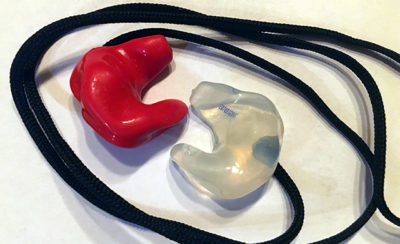There are a variety of hearing protection products on the market, but the custom-molded solution provides the best combination of comfort and protection
You know the dangers of not protecting your hearing. You also know the benefits to your job at the racetrack of doing so. The question remaining to be answered is, “What is the best way to protect one’s hearing?” The answer, as it almost always is, “It depends.”
Do you need to listen to a radio? Do you need to hear people speak? Do you just need to shut out the noise? One’s individual needs dictate the level of hearing protection required.
Hearing protection ranges from the basic foam earplugs to custom-molded passive hearing protection or earbuds. Like everything else, you get what you pay for.
“There is no substitute for products that are crafted using an actual mold of an individual’s ear,” says L. Dawn Flinn, a licensed audiologist and principal at earEVERYTHING, Inc, a supplier of hearing protection equipment and, as one might suspect, custom-molded hearing protection solutions. “If having a custom-made product is not an option, there are plenty of over-the-counter choices that can help. The wonderful thing about a customized product is it fits the same way every time, assuring you the same level of protection with every use.”
Flinn says the foam ear plugs and one-size-fits-all silicone solutions are better than nothing, but notes that many people don’t insert them properly and, after all, whose ear canals are perfectly cylindrical?
A bigger issue, perhaps, is the fact that such hearing protection – even custom-molded solutions – may provide more protection than you need. Yes, they block the loud noises, but they block the sounds you may need to hear as well.
“You can’t have effective communication in the presence of noise without effective hearing protection. We have passive hearing protectors with filters in them that allow you to hear speech and the tone of the engine and the tools that you’re using. When you’re using an air gun, if there’s something not right with the air gun, you have to hear it,” she says.
The same thing is true with radios. More than just an earbud, a custom-molded solution better blocks out outside noise. Otherwise it is very possible that a driver or crewman will have to turn the volume so loud that it will actually damage their hearing more than the race car noise.
“If I create an earpiece for you and it creates a seal separating the sound on the outside from what you’re trying to listen to on the inside, you don’t require a ton of volume. If you are using your volume control to overpower ambient sound, you run the risk of listening at even higher volumes than the race cars. This will cause the same type of hearing damage you were trying to avoid in the first place,” she says.
Naturally, Flinn believes she takes a really good ear impression after what she estimates are 15 or 16,000 of them. But while Flinn operates out of Indianapolis and travels to many IndyCar and IMSA races, getting her to do an impression of your ear isn’t always a possibility, so she mentions that it’s also effective to have another audiologist take a mold of your ear and have it sent to earEVERYTHING to create the hearing protection product. Either way, Flinn is a strong believer in the custom-molded solution, believing that it provides superior hearing protection and easy fit.


 ACCESSIBILITY
ACCESSIBILITY